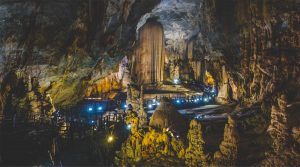The Tu Lan Cave System is a true hidden gem in Vietnam’s Phong Nha-Ke Bang region, offering an extraordinary adventure for thrill-seekers and nature lovers. Located in the heart of a vast limestone mountain range and surrounded by pristine jungle, Tu Lan boasts over 20 stunning caves connected by an underground river system. These caves provide some of the most unique caving experiences in Vietnam, from kayaking in underground rivers to trekking through unspoiled wilderness.
About Tu Lan Cave System
The Tu Lan Cave System is situated in the pristine forests and limestone mountains of Tan Hoa Commune, Minh Hoa District, Quang Binh Province. Covering over 650 hectares, the area includes more than 20 caves spread across eight different valleys, connected by an underground river system. Discovered in 1992 by the British-Vietnam Caving Expedition Team, the system has been continuously explored, revealing a fascinating world of dry and wet caves.
A Cave Network Outside Phong Nha National Park
While most visitors associate Phong Nha with its famous national park, the Tu Lan Cave System lies outside the protected area, about 70 kilometers northwest of Phong Nha-Ke Bang National Park. This independent cave system was carved out by the Rao Nan River, which flows through the surrounding communes, creating an expansive underground labyrinth.
Formation of the Cave System
Tu Lan was formed by the Rao Nan River, which carved through limestone mountains over millions of years. This erosion process created a series of interconnected caves and valleys, each offering distinct features. The river continues to flow through the caves, creating underground rivers and breathtaking waterfalls inside the cave system.
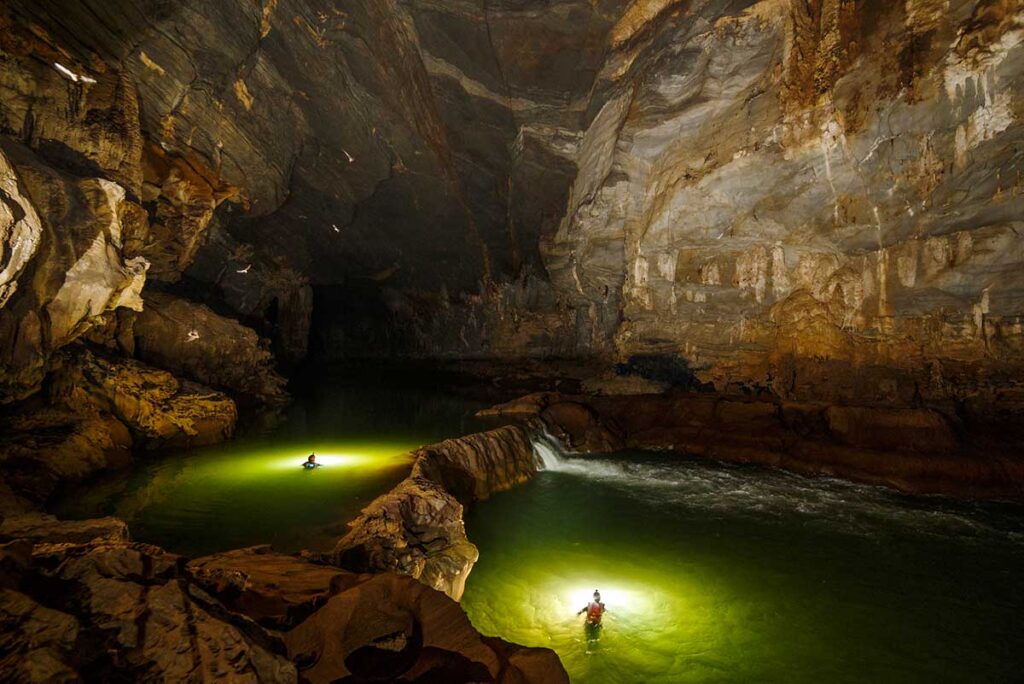
Historical Discoveries
Many of the caves in Tu Lan were known to locals for years before being formally documented. In 2009, a local man named Dinh Hong Nham discovered Tu Lan Cave while fishing near its entrance. In 2010, a British caving team led by Howard Limbert surveyed the caves and, along with National Geographic photographer Carsten Peter, brought international attention to the area. Peter’s award-winning photos of Ken Cave helped raise awareness about the Tu Lan caves, showcasing their stunning formations and remote beauty.
The Meaning Behind the Name
The origin of the name Tu Lan is believed to come from the Nguon language. “Lan” refers to the Nan River, which flows into the Tu Lan Valley and disappears underground, while “Tu” is thought to describe the surrounding limestone mountains. These mountains encircle the valleys, creating a visually striking landscape of jagged peaks and lush jungle.
Caves parts of Tu Lan Cave System
The Tu Lan Cave System is home to more than twenty caves, each with its own unique features and formations. From impressive dry caves to spectacular wet caves connected by underground rivers, Tu Lan offers a diverse and exciting caving experience.
Rat Cave
Rat Cave was the first cave discovered in the Tu Lan area in 1992. This dry cave spans over 280 meters in length and boasts a wide passage up to 30 meters at some points. Its spacious entrance and flat floor have made it a popular filming location for Vietnamese movies like The Immortal and The Legend of Quan Tien. The cave’s size and accessibility make it an impressive spot to explore.
Secret Cave
Discovered accidentally by porters in 2013, Secret Cave is a short but visually stunning cave. Though less than 200 meters long, it features wide passages up to 15 meters and fascinating stalactites. One of the most notable formations inside the cave is the collection of cave pearls, small spherical stones that form from mineral deposits, making it a unique spot for geology enthusiasts.
Hung Ton Cave
Hung Ton Cave was initially surveyed in 1992, with further exploration revealing a second entrance in 2012. This cave is known for its historical significance, as skeletons and seashells found within suggest it was once used as a shelter by ancient people. Hung Ton Cave is nearly 500 meters long and requires a 15-meter ladder climb, followed by swimming through sections of the underground river, making it a more adventurous experience.
Ken Cave
Discovered in 2010, Ken Cave is the longest river cave in the Tu Lan system, stretching over 3 kilometers. The cave’s wide entrance and massive underground river make it a popular highlight for visitors. One of the most iconic features of Ken Cave is the impressive waterfall that flows out of its entrance, which was first seen by caving experts in 2011. The cave’s stunning formations have been captured in award-winning photos, bringing international attention to its beauty.
Tu Lan Cave
Tu Lan Cave, discovered alongside Ken Cave in 2010, is one of the largest and most visually striking caves in the system. With a passage that’s up to 35 meters wide, the cave features towering stalactites and columns that resemble natural chandeliers. The grandeur of this cave makes it a favorite among visitors, and its vast chambers give it the feeling of a hidden underground castle.
Hang Kim
Hang Kim was discovered in 2012 by a Dutch tourist and later surveyed by the British-Vietnam Cave Expedition Team. The cave is over 1.2 kilometers long and offers a mix of dry and wet passages. Visitors can swim through the underground river and navigate the rock formations, making it one of the most exciting caves in the Tu Lan system.
Hang Tien 1 & Hang Tien 2
Hang Tien 1 was surveyed in 1994 and is one of the most spectacular caves in the system, with a 45-meter-wide passage and a stunning ceiling dome. Hang Tien 2, discovered in 2015, connects with Hang Tien 1 via an underground river. Together, these caves are the largest in the Tu Lan system, offering a thrilling experience with their multi-level passages and impressive formations.
Tu Lan Cave Tours & Caving Expeditions
The only way to explore the Tu Lan Cave System is by booking a guided adventure tour. Given the system’s vast size and remote location, these tours offer a safe and exciting way to discover the caves and surrounding jungle. There are several tour options, ranging from single-day excursions to multi-day expeditions, each offering a different level of adventure.
1-Day Tu Lan Experience
The Tu Lan 1-Day Experience is a highly rated adventure tour, ideal for those who want a taste of caving in just one day. This tour includes rock scrambling, trekking through the jungle, and swimming through Hung Ton Cave, a wet river cave that requires about 50 meters of swimming. Along the way, you’ll cover up to 9 kilometers of trails, passing through lush forests and valleys. The Tu Lan 1-Day Experience is perfect for travelers who want a brief but thrilling introduction to the cave system.
2-Day Tu Lan Cave Encounter
The 2-Day Tu Lan Cave Encounter is the most popular overnight jungle and cave tour in the region. This tour takes you through 12 kilometers of jungle and caves, including the magnificent Tu Lan Cave, which was featured in National Geographic. You’ll trek through both dry and wet caves, wade through underground rivers, and camp overnight in the jungle. With its combination of adventure, stunning cave formations, and immersive jungle experience, the Tu Lan Cave Encounter is a favorite among adventurous travelers.
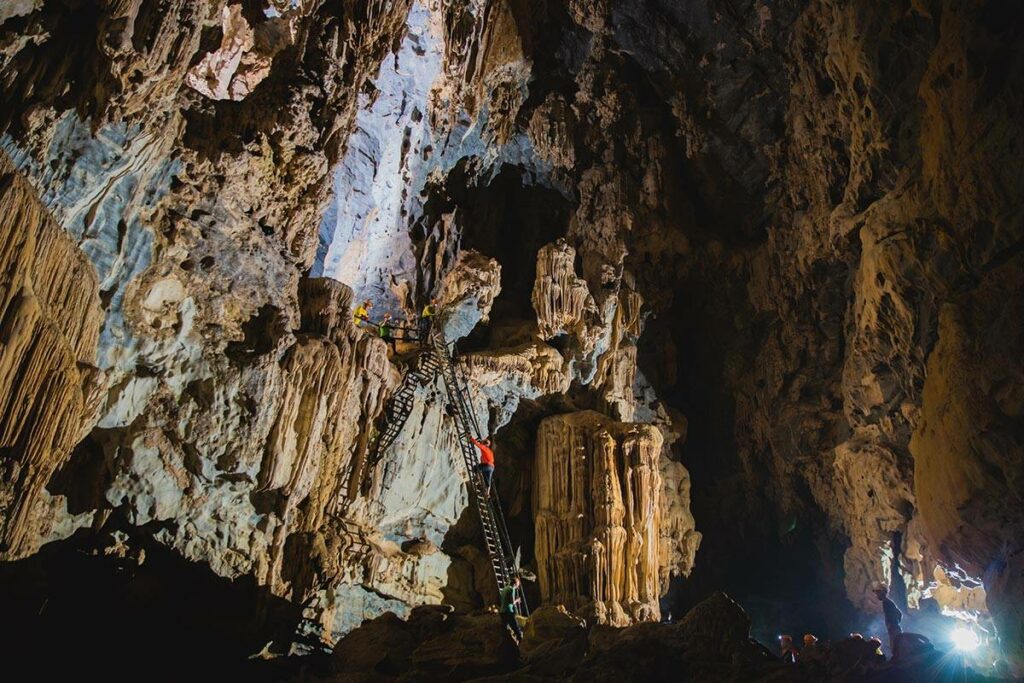
4-Day Tu Lan Expedition
For those looking for the ultimate Tu Lan adventure, the 4-Day Tu Lan Expedition offers an in-depth exploration of the cave system, including Hang Tien, the largest cave in the region. This expedition covers all the major caves in Tu Lan, such as Kim Cave and Secret Cave, and includes trekking, rock climbing, and swimming in underground rivers. The tour also features camping in remote jungle locations, offering a truly immersive wilderness experience. With its small group sizes and challenging activities, the Tu Lan Expedition is recommended for those with previous trekking experience and a good level of fitness.
Highlights of Tu Lan Cave
The Tu Lan Cave System offers a variety of stunning natural features that make it one of the most unique caving experiences in Vietnam. From underground rivers to dramatic cave formations, Tu Lan is filled with adventure and breathtaking scenery. Here are some of the highlights you can expect to encounter:
1. Stunning Waterfalls
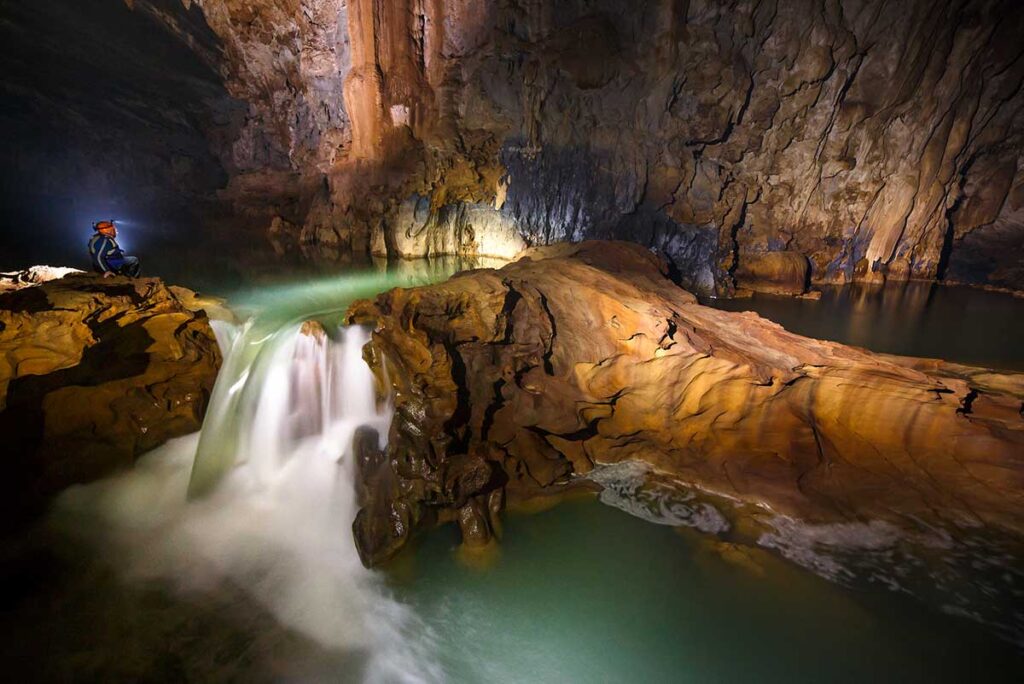
Many of the caves in Tu Lan are connected by an underground river that flows through the system, creating a series of beautiful waterfalls. The height difference between the valleys is around 5 to 10 meters, which results in cascading waterfalls that emerge inside the caves. Some of these waterfalls flow out of the cave entrances, forming natural pools surrounded by limestone cliffs and jungle, creating a picturesque setting that’s perfect for photography.
2. Unique Cave Formations
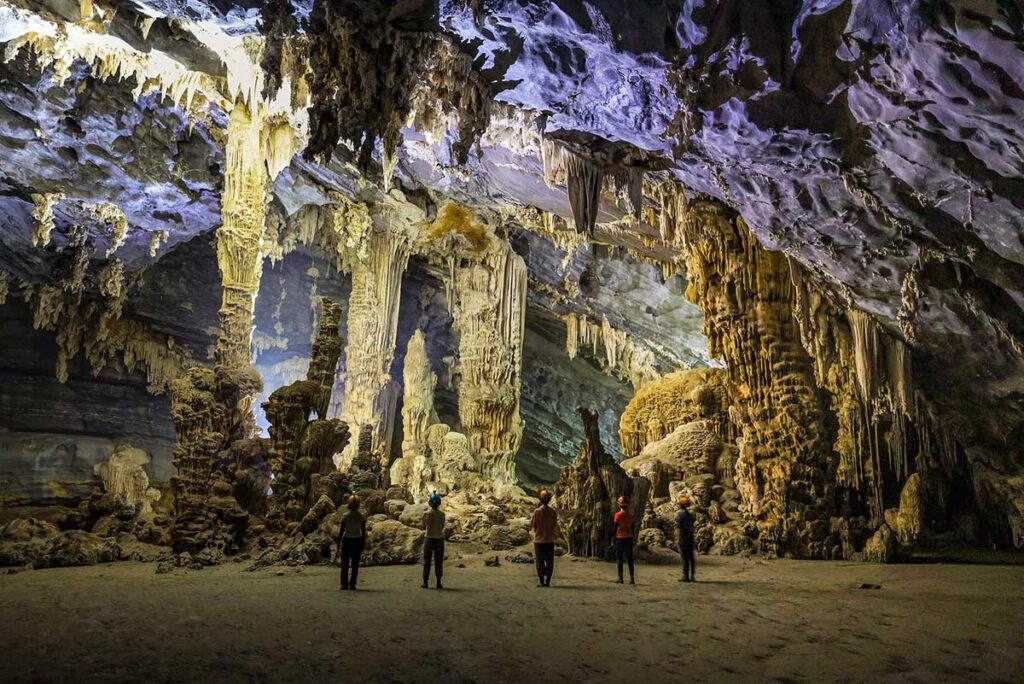
The caves in Tu Lan are known for their fascinating formations, including tower coral formations in caves like Hang Song and Dry Ken. You’ll also find gour pools—terraced pools resembling rice paddies—inside some of the caves. In Ken Cave and Rat Cave, sunlight streams into the cave through openings, illuminating the formations and creating magical effects. The famous photos of Ken Cave, taken by National Geographic photographer Carsten Peter, showcase some of these impressive formations and have won international awards.
3. Swimming in Underground Rivers

One of the most exciting parts of exploring the Tu Lan Cave System is swimming through the underground rivers. Wet caves like Hung Ton Cave, Kim Cave, Tu Lan Cave, and Ken Cave require you to swim through sections of the river to reach different parts of the caves. This experience of swimming in the dark, surrounded by ancient formations, is one of the most thrilling activities in Tu Lan.
4. Exploring the Jungle
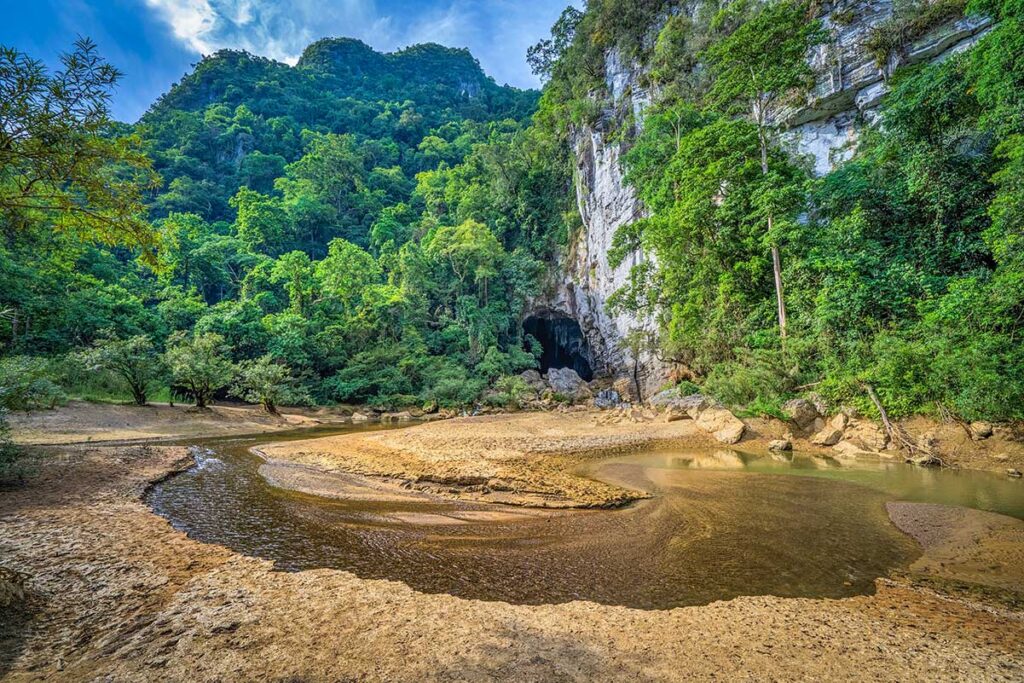
The Tu Lan caves are nestled in eight valleys surrounded by limestone mountains and dense jungle. Trekking through the jungle to reach the caves is an adventure in itself, with lush green forests, crystal-clear rivers, and rugged terrain. Each cave entrance leads to a new discovery, and the jungle pathways connecting them provide a true wilderness experience.
5. Camping in the Wilderness
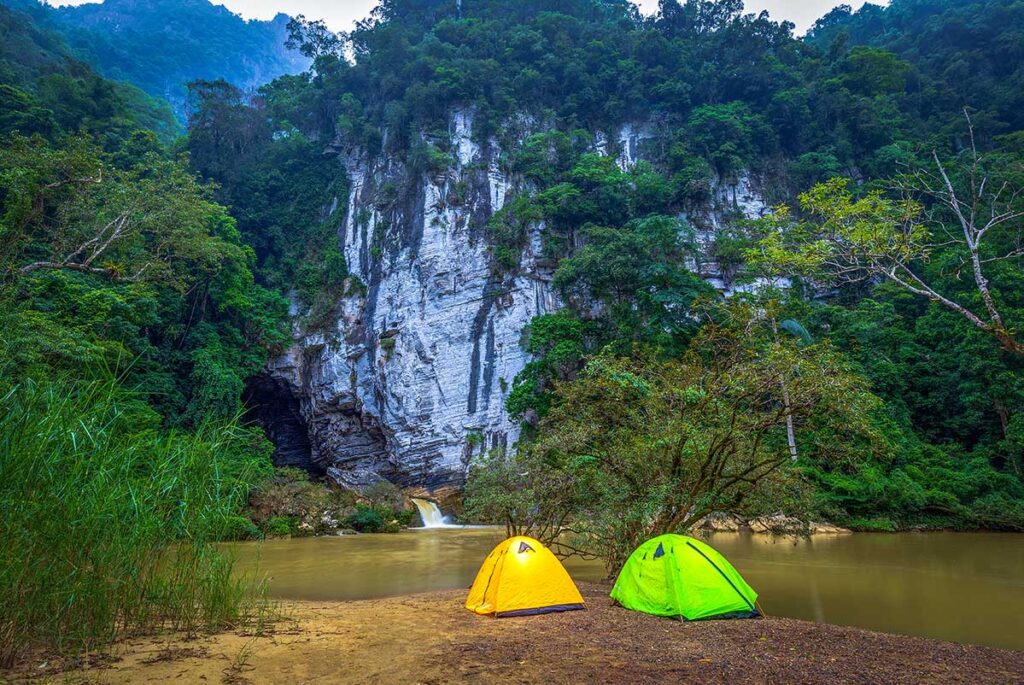
For overnight tours, one of the best parts of the Tu Lan experience is camping in the heart of the jungle. Campsites are typically set up in idyllic spots, like the Tu Lan Valley, where a waterfall flows out of Ken Cave into a natural pool. Guests can relax by the water, swim in the pools, and enjoy the peaceful surroundings. Falling asleep to the sounds of the jungle, with the towering limestone cliffs above you, is an unforgettable experience.
Best time to visit
Tu Lan Cave tours are available from November to September, with the weather dictating the best time to visit. The cooler months from January to March are ideal for trekking, while the summer months from June to September offer warm conditions perfect for swimming in the caves. Tours are closed during the rainy season to protect the delicate cave system.
How to get there
To explore the Tu Lan Cave System, you’ll need to join a guided tour that departs from Son Trach Town, the main base for visitors to Phong Nha National Park. Here’s how you can get there:
Direct buses
There are direct buses to Phong Nha from nearby cities such as Ninh Binh and Hue. These buses are convenient and affordable, offering travelers an easy way to reach Son Trach Town without having to transfer in Dong Hoi. However, options are limited to a few daily buses, so it’s important to check the schedule ahead of time.
Private car
If you prefer more comfort and flexibility, hiring a private car is another option. This is ideal for short-distance travel from nearby areas, but keep in mind that longer trips can be more expensive. For those traveling with family or a group, this can be a convenient way to travel at your own pace.
Arriving from Dong Hoi
If you’re coming from further away in Vietnam, you’ll first need to travel to Dong Hoi, the nearest city to Phong Nha. From Dong Hoi, there are a few options for reaching Son Trach Town:
- Flights: Dong Hoi has a small airport with direct flights from Hanoi and Ho Chi Minh City. This is the fastest way to reach the area if you’re coming from a major city.
- Train: Dong Hoi is also a stop on the North-South Reunification Railway, which runs between Hanoi and Da Nang. The train is a scenic and comfortable way to travel, especially for those looking to enjoy the countryside views.
- Bus: As Dong Hoi is located on the main route between Hanoi and Da Nang, many buses stop here. Buses are one of the most budget-friendly options for travelers.
From Dong Hoi to Phong Nha (Son Trach Town)
Once you arrive in Dong Hoi, you can take a public bus or a private taxi to Son Trach Town, which is about a 45-minute drive. The public bus costs between 2 to 3 USD and is the cheapest option, while a taxi or private car will get you there faster for around 15 to 25 USD.
Tips for visiting Tu Lan Cave
Visiting Tu Lan Cave requires a bit of preparation to ensure you have the best experience. Here are some important tips to keep in mind before embarking on your adventure.
1. Choose the right season
As mentioned earlier, the Tu Lan Cave System is closed during the rainy season from October to early November, so it’s important to plan your trip during the dry season for optimal conditions. The best time to visit is between April and September, when the weather is warm, the jungle is lush, and swimming in the caves is most enjoyable.
2. Book in advance
Tu Lan Cave tours are very popular, especially during the peak travel months. Booking your adventure well in advance is essential, as the tours have limited spots and require small group sizes to preserve the natural environment and ensure safety. During peak season, slots can fill up quickly.
3. Pick the right level of adventure
The Tu Lan Cave System offers a range of tours that vary in difficulty. Whether you’re a first-time adventurer or an experienced trekker, it’s important to choose the right tour based on your fitness level and experience. Single-day tours are more beginner-friendly, while multi-day expeditions require more stamina and experience in caving and trekking.
The caves and jungle of Phong Nha
While Tu Lan offers some of the best caving experiences in Vietnam, Phong Nha-Ke Bang National Park is home to many other incredible caves, from easy-to-explore caves like Paradise Cave to more challenging expeditions such as Hang Son Doong, the world’s largest cave. Discover the best caves in Phong Nha for your next adventure.
Booking a Phong Nha caving expedtions
At Local Vietnam, we specialize in creating personalized, unforgettable travel experiences in Vietnam. We know all the best options for exploring the Tu Lan Cave System and can help arrange your adventure through official, licensed tour operators and guides. Whether you’re interested in a single-day Tu Lan experience or a multi-day expedition, we can tailor the trip to meet your needs.
Why book with Local Vietnam?
- Expert knowledge: We know all the caves in Phong Nha and can match you with the best caving experience based on your fitness level, time available, and adventure preferences. We also ensure your trip is safe and eco-friendly.
- Custom itineraries: If you want to make Tu Lan just one part of a larger trip, we can build a complete itinerary around your visit. We offer transportation, accommodation, and additional tours to explore more of Phong Nha’s jungle, caves, and cultural highlights.
- Tailored experiences: Whether you prefer jungle trekking, caving, or a mix of both, we can create a customized trip for you. For those with limited time or specific interests, we also offer short tours and flexible options to fit your schedule.
How to book
To book your Tu Lan Cave adventure or a complete custom Vietnam trip, fill in the custom request form here. Our team will work with you to plan the perfect experience, ensuring you make the most of your time in Vietnam’s breathtaking natural landscapes.


